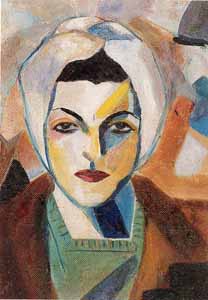Saloua Raouda Choucair facts for kids
Quick facts for kids
Saloua Raouda Choucair
|
|
|---|---|

Self Portrait, 1943
|
|
| Born | June 24, 1916 |
| Died | January 26, 2017 (aged 100) |
| Nationality | Lebanese |
| Education | American Junior College for Women (presently the American University of Beirut), École Nationale des Beaux Arts |
| Known for | Painting, Sculpture |
| Movement | Abstract Art |
| Spouse(s) | Youssef Choucair (1914-1999) |
Saloua Raouda Choucair (Arabic: سلوى روضة شقير; June 24, 1916 – January 26, 2017) was a famous Lebanese painter and sculptor. She is known for her amazing abstract art, which means her art didn't try to show real-life objects but instead used shapes, colors, and lines to create feelings or ideas. She was a very important artist in the Arab world and helped shape modern art in Lebanon.
Contents
Early Life and Artistic Beginnings
Saloua Raouda Choucair was born in 1916 in Beirut, Lebanon. Her family included many educated people like doctors and lawyers. Her father, Salim Rawda, was a trader and writer who sadly died when Saloua was very young, in 1917. Her mother, Zalfa Amin Najjar, raised Saloua and her two older siblings. Saloua's mother was a strong and educated woman who loved poetry. She was a great inspiration to Saloua.
From a young age, Saloua loved art. She felt that art was a natural part of her. She made many handmade objects when she was little. At Ahlia School in 1924, she designed posters and drew funny pictures of her teachers for the school newspaper. She even helped other students with their art, feeling she knew more than her own art teachers! She once joked that she spent a lot of time in the hallway because she was so social.
After high school, Saloua studied natural sciences at the American Junior College for Women from 1934 to 1936. In 1942, she took art lessons for only three months with a painter named Omar Onsi. Most of her artistic skills she learned on her own.
Discovering Abstract Art
Saloua's travels greatly influenced her art. In 1943, during World War II, she went to Egypt. Many museums were closed, so she explored the streets of Cairo and visited mosques. This experience deeply moved her. She felt that Islamic art was "real art" that would last forever. She loved how Islamic art used shapes and patterns.
She also loved architecture, calling it her "second love." She started as a painter but then moved to sculpture, combining her love for both. Her sculptures often used precise geometric shapes. She believed that the "point" was the basic idea in Arab art, and everything else came from it. She wanted to show that Islamic art was not just decorative but had deep artistic principles.
After seven months in Cairo, Saloua returned to Lebanon. In 1945, she worked at the American University of Beirut (AUB) library and took philosophy and history classes. In 1947, she had an exhibition of her geometric drawings in Beirut. This show is thought to be the first exhibition of abstract painting in the Arab world.
In 1948, Saloua traveled to Paris. She wanted to learn more about the art world beyond what she knew, like Post-impressionism. In Paris, she saw abstract art for the first time. She explored galleries and museums every day. She decided to stay in Paris and studied at the École Nationale des Beaux Arts. She also joined the studio of a famous artist named Fernand Léger in 1949, but she left after three months because his ideas didn't match her own artistic goals.
Exhibitions and Sculpture Focus
In 1950, Saloua was one of the first Arab artists to show her work at the Salon des Réalités Nouvelles in Paris. Before returning to Lebanon, she had her first solo exhibition in Paris in 1951. Critics loved her work, praising her strong forms and saying her paintings were so powerful they seemed to make the gallery walls "burst."
In 1959, Saloua started focusing more on sculpture, and by 1962, it became her main artistic focus. In 1963, she won a prize to create a stone sculpture for a public space in Beirut. In 1974, she had a special exhibition of her work in Beirut. She also received an award from the General Union of Arab Painters in 1985 and a medal from the Lebanese government in 1988.
In 2013, the Tate Modern museum in London held a big exhibition of Saloua's work. This was the first time her art was shown on such a large scale internationally. Her art is seen as a great example of abstract art from the Arab world, inspired by Arabic geometric patterns and not by looking at nature.
In 2014, the American University of Beirut gave her an honorary doctorate, which is a very special award. Her artwork "Poem" is now displayed at the Louvre Abu Dhabi museum.
Saloua Raouda Choucair turned 100 years old in June 2016. She married journalist Youssef Choucair in 1953, and they had a daughter named Hala, who also became an artist. Saloua Choucair passed away on January 26, 2017, in Beirut.
Tribute
On June 24, 2018, Google Doodle honored Saloua Raouda Choucair on what would have been her 102nd birthday.
Selected Exhibitions
Solo Exhibitions
- "Saloua Raouda Choucair: The Meaning of One, The Meaning of the Multiple", Mathaf: Arab Museum of Modern Art, Doha, 2015.
- Noble Forms, Salwa Raouda Choucair, Maqam Art Gallery, Beirut, 2010.
- Retrospective. Salwa Raouda Choucair, Beirut Exhibition Center, 2011.
- Saloua Raouda Choucair, Tate Modern, 2013.
Group Exhibitions
- The Road to Peace, Beirut Art Center, 2009.
- Art from Lebanon, Beirut Exhibition Center, 2012.
See also
 In Spanish: Saloua Raouda Choucair para niños
In Spanish: Saloua Raouda Choucair para niños

